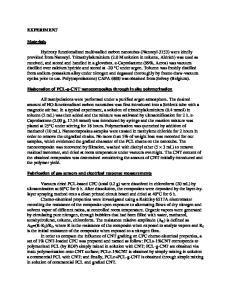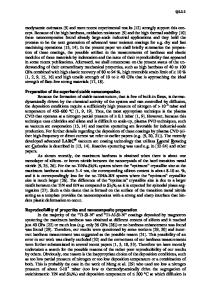Mechanical, electrical and thermal properties of graphene oxide-carbon nanotube/ ABS hybrid polymer nanocomposites
- PDF / 5,168,698 Bytes
- 16 Pages / 595.276 x 790.866 pts Page_size
- 30 Downloads / 379 Views
ORIGINAL PAPER
Mechanical, electrical and thermal properties of graphene oxide-carbon nanotube/ ABS hybrid polymer nanocomposites Jeevan Jyoti 1,2 & Abhishek K. Arya 1 & Sreekumar Chockalingam 1 & Shailesh K. Yadav 1 & Kiran M. Subhedar 1 & S. R. Dhakate 1 & Bhanu Pratap Singh 1,2 Received: 6 February 2020 / Accepted: 11 August 2020 # The Polymer Society, Taipei 2020
Abstract Multiwalled carbon nanotubes (MWCNTs), functionalized carbon nanotubes (FCNTs) and graphene oxide-carbon nanotube (GCNTs) hybrid Bucky paper (BP) reinforced acrylonitrile-butadiene-styrene (ABS) composites are prepared via vacuum filtration followed by hot compression molding. The nanomechanical, electrical and thermal properties of these BP reinforced ABS composites are studied. The nanoindentation hardness and elastic modulus of GCNTs-ABS hybrid composites reached to 389.98±91.79 MPa and 7669.6±1179.12 MPa respectively. Other nanomechanical parameters such as plastic index parameter, elastic recovery, the ratio of residual displacement after load removal and displacement at maximum load are also investigated. The improved nanomechanical properties are correlated with Raman spectroscopy and scanning electron microscopy (SEM). It is found that GCNTs and their composites showed the higher value of defect density. The maximum value of defect density range for GCNTs and GCNTs-ABS is (297.4 to 159.6) and (16.0 to11.6), respectively. The higher defect density of GCNTs indicates that the interfacial interaction between the ABS, which was further correlated with electrical and thermal properties. Additionally, the through-plane electrical conductivities of MWCNTs, FCNTs and GCNTs based ABS composites were 6.5±0.6, 4.5±0.7 and 6.97±1.2 S/cm respectively and thermal conductivities of MWCNTs, FCNTs and GCNTs reinforced ABS composites; 1.80, 1.70 and 1.98 W/mK respectively. These GCNTs-ABS composites with this value of thermal conductivity can be used in various applications of efficient heat dissipative materials for electronic devices. Keywords Bucky paper . Multiwalled carbon nanotube (MWCNTs) . Functionalized carbon nanotube (FCNTs) . Graphene oxide-carbon nanotube (GCNTs)
Introduction In the past few years, reinforcement of nanofillers in polymer composites has been drawing much more attention due to their extraordinary properties. The nanofiller-reinforcement enhances the mechanical, electrical and thermal properties of polymer composites. Incorporation of different type of carbon Electronic supplementary material The online version of this article (https://doi.org/10.1007/s10965-020-02252-9) contains supplementary material, which is available to authorized users. * Bhanu Pratap Singh [email protected]; [email protected] 1
Advanced Carbon Products and Metrology, Advanced Materials and Devices Metrology, CSIR-National Physical Laboratory, Dr. K.S. Krishnan Marg, New Delhi, India
2
AcSIR-National Physical Laboratory, New Delhi 110012, India
nanomaterials such as carbon nanofiber, carbon nanotubes (CNTs), graphene, graphene oxide (GO) and red
Data Loading...











